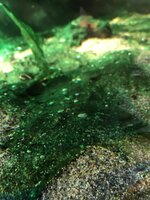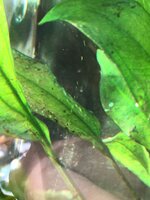FishLifeLondon
Member
I have quite a few questions.
Firstly, I would like to replant and rescape my aquarium and maybe add a new substrate. It is an established aquarium with 4 lampeyes, 2 young platies, 4 nerite snails and 4 amano shrimp. I have a canister filter and a superfish retrofit T8 led light for a 35cm depth and a 63l aquarium. I have about an inch of inert sand. I would like to plant rotala rotundifolia, hygrophillia corymbosa compact, s.repens (maybe), hydrocotyle, java moss and a banana lily.
I want to know wether I could be able to support these plants or what I need to provide in order to do so (root ferts, liquid ferts and carbon or a plant substrate). If I were to add a planted substrate or soil, would I need one that would not leach ammonia.
I also would like to know about my water chemistry. My London tap water has 30ppm of nitrate and my aquarium water has a pH of 8.2-4, I will hopefully find out kh and gh tomorrow. I am wondering wether RO water combinations with tap water or remineralised RO water would give better parameters for plant growth and also for Norman's lampeyes and daisy blue ricefish which I would like to stock after the rescape and what ratios to mix.
Another thing I would like to understand is about cycling (yes this is an established aquarium) and what adding more fish does to the bacteria population and how it would deal with more ammonia production and how I should do it and what sort of stocking levels would be appropriate.
I also have an algae problem and would like to know what the algae is and how to deal with it

And is this pearling

Firstly, I would like to replant and rescape my aquarium and maybe add a new substrate. It is an established aquarium with 4 lampeyes, 2 young platies, 4 nerite snails and 4 amano shrimp. I have a canister filter and a superfish retrofit T8 led light for a 35cm depth and a 63l aquarium. I have about an inch of inert sand. I would like to plant rotala rotundifolia, hygrophillia corymbosa compact, s.repens (maybe), hydrocotyle, java moss and a banana lily.
I want to know wether I could be able to support these plants or what I need to provide in order to do so (root ferts, liquid ferts and carbon or a plant substrate). If I were to add a planted substrate or soil, would I need one that would not leach ammonia.
I also would like to know about my water chemistry. My London tap water has 30ppm of nitrate and my aquarium water has a pH of 8.2-4, I will hopefully find out kh and gh tomorrow. I am wondering wether RO water combinations with tap water or remineralised RO water would give better parameters for plant growth and also for Norman's lampeyes and daisy blue ricefish which I would like to stock after the rescape and what ratios to mix.
Another thing I would like to understand is about cycling (yes this is an established aquarium) and what adding more fish does to the bacteria population and how it would deal with more ammonia production and how I should do it and what sort of stocking levels would be appropriate.
I also have an algae problem and would like to know what the algae is and how to deal with it

And is this pearling

Last edited:


